Interim Executive Dining Facility Bridges Construction Gap at Business School
Harvard chooses quality, speed, and sustainability with a frame-supported, architectural membrane-clad, modular food service complex
![]() Continuing Education
Continuing Education
Use the following learning objectives to focus your study while reading this month’s Continuing Education article.
Learning Objectives - After reading this article, you will be able to:
- Explain the value of a team approach to quickly mobilizing a high-end interim structure.
- Compare the energy efficiency profile of a properly insulated architectural fabric structure to that of a pre-engineered metal building and conventional construction.
- List the advantages of a coated architectural membrane.
- Evaluate the cost effectiveness of a modular interim kitchen facility vs. other alternatives.
Harvard Business School's Kresge Hall, which was built in the 1950s and served primarily as an executive education dining center, was slated to be torn down to make space for a replacement facility. While the B school stood to gain an important new building, a pressing question became what to do in the meantime. How could Harvard accommodate the scores of prestigious executives who came to attend its executive education program in the style to which they had become accustomed—all in a high-end solution that could be mobilized quickly, cost effectively, sustainably and, above all, not look like a temporary solution but like a permanent facility that fit well with other buildings on campus? This article will discuss how Harvard solved this dilemma and the design team's process, challenges, and accomplishments, and go on to describe the elements of such a facility from both a structural and foodservice operations standpoint. Also covered will be experiences with similar interim facilities at other universities.
The Harvard Experience
Harvard University has replaced its famed Kresge Hall in order to make space for the new Ruth Mulan Chu Chao Center, following a $40-million donation by the Chao family. The new center is named after Ruth Mulan Chu Chao, wife of James Si-Cheng Chao and the mother of six daughters, four of whom graduated from the Business School. The Chao Center, which broke ground in 2014, is slated to open in July 2016, and will serve as a central space for participants in the executive education program by providing classrooms, dining services, and offices.

Image courtesy of Kitchens To Go
After much deliberation, Harvard Business School opted to go with an architectural membrane structure and high-tech modular kitchen structures whose refined finishes and exterior appearance fit the university’s objectives.
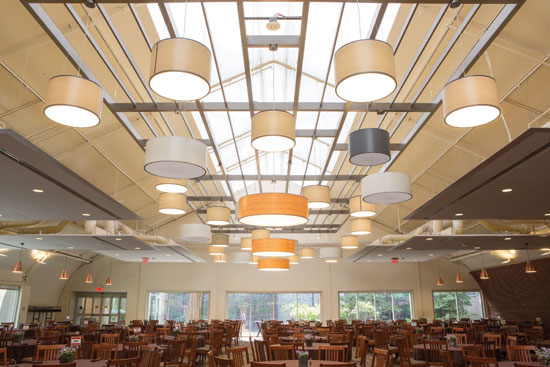
Photo courtesy of Kitchens To Go/Sprung Structures
To deal with that extensive space, the design team utilized acoustical ceiling clouds with ceiling fixtures and dropped pendants.
Bridging the gap during construction and providing the same high-quality dining services to its prominent clientele took Harvard beyond the obvious solutions. In any such situation, the alternatives include off-the-shelf, temporary trailers, which, in this case, lacked a quality finished look consistent with Harvard's prestigious image, or a conventional building, which would have required a significantly longer build out. After much deliberation, Harvard Business School, or the B School, as its commonly known, opted to go with an architectural membrane structure and high-tech modular kitchen structures whose refined finishes and exterior appearance fit the university's objectives. The interim executive education dining and kitchen facility has been operating since March 2014 while the new facility is being built, and has met key aesthetic considerations as well as strict budgets and timelines—a solution that was not previously available on such a high level.
The Importance of Color
A key factor in Harvard's decision to go with a membrane structure was color—specifically, the fact that the membrane exterior could be color matched to the exterior of the existing architecture at Harvard. The university took advantage of a new development—a Kynar®-coated1 membrane, the only such product currently available that provides a proven color-fast solution that will not fade. Previously available on metal coatings, within the past few years Kynar has become available as a coating on membrane. Kynar is a polyvinylidene fluoride (PVDF) resin2 used in the makeup of fluoropolymer resin-based coatings. Fluoropolymer resin-based coatings take advantage of the inherent strength of the carbon-fluorine bond, one of the strongest known to science.
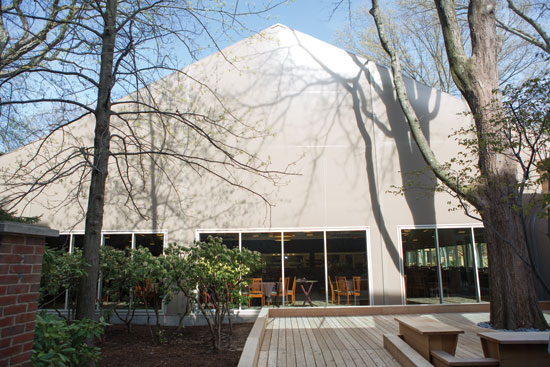
Photo courtesy of Kitchens To Go/Sprung Structures
A key factor in Harvard’s decision to go with a membrane structure was color—specifically, the fact that the membrane exterior could be color matched to the exterior of the existing architecture at Harvard.
A Tensioned Membrane Structure with High-End Finishes
Architecturally, the interim facility is a tensioned membrane structure that is made up of a series of aluminum frames covered with a polyvinyl chloride (PVC) membrane stretched between them. The structure itself, which utilizes a number of 5-foot 10-inch aluminum I-beams to span the 80-foot width, is set up to be a permanent facility (though relocatable in design) and will be on site for up to 32 months. Full HVAC facilities are incorporated to keep occupants cool in summer and warm during the winter months—this works very efficiently thanks to the 8-inch-thick (r25) blanket of fiberglass insulation within the walls of the structure.
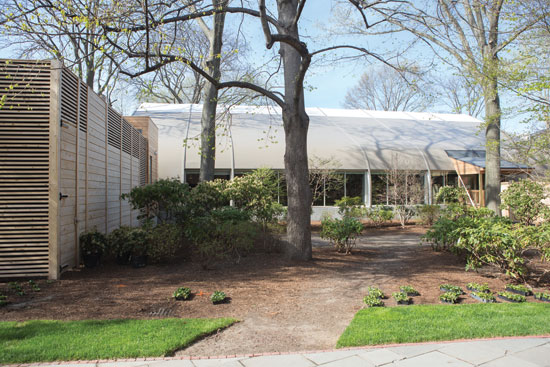
Photo courtesy of Kitchens To Go/Sprung Structures
The structure is set up to be a permanent facility (though relocatable in design) and will be on site for up to 32 months.
The university brought in a noted design team, Shepley Bulfinch, to work specifically on the interior of the dining and servery area. Designers specified high-end finishes and solved multiple space issues. “The volume was the piece we focused on the most,” says Sara DiNoto, associate at Shepley Bulfinch. One challenge was fitting the required number of seats and the servery within the length and width of the structure, and creating viable transitions between the seating area and the servery. “We looked at a few ways of how we were going to anchor the space with the servery,” says DiNoto, explaining that ultimately a few partitions were built to create an endpoint and serve as a “storefront” for that piece of the structure.
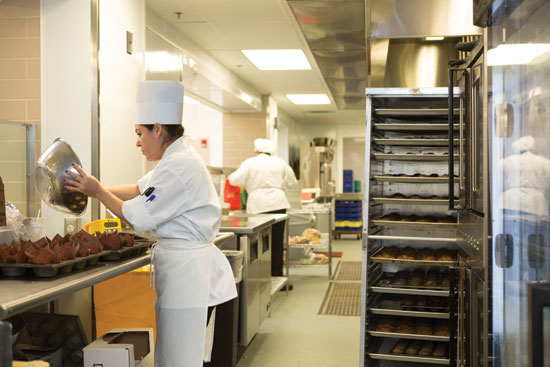
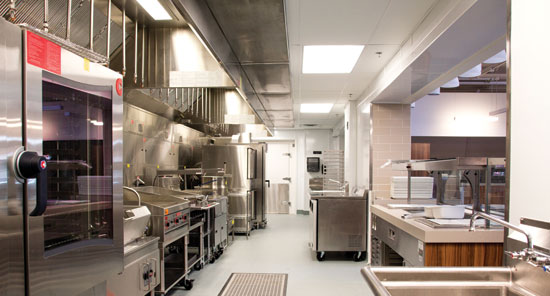
Photos courtesy of Kitchens To Go/Sprung Structures
The interim kitchen facility at Harvard Business School is an aesthetically pleasing structure with code-compliant, food service grade finishes.
Another issue was the high ceiling which afforded considerable volume above the usable portion of the building. To deal with that extensive space, the design team utilized acoustical ceiling clouds with ceiling fixtures and dropped pendants. At the center, however, an open ceiling system with larger drum pendants was employed both to allow light from the daylight panels to shine through and to adjust the scale of the building.
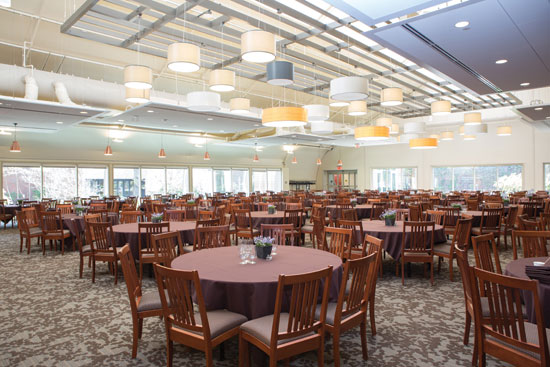
Photo courtesy of Kitchens To Go/Sprung Structures
Interim kitchen and dining facilities are a high-quality, cost-effective solution when renovating permanent structures.
The foodservice production facilities include cooking modules, prep modules, and cold and dry storage facilities as well as a 24-hour in-house bakery, all of which function to serve breakfast, lunch, and dinner. Breakfast is cooked entirely in house, and for lunch and dinner, some of the foods are brought in already prepared, such as the soup offerings. Other foods are finished and cooked in the facility, so the preparation and cooking area is used as a finishing kitchen and also as a full-function bakery, with all areas consolidated into an effective workflow.
Staff locker rooms and wash rooms are also included in the structure. In one of the key features of the interim dining and kitchen complex, designers integrated a series of enclosed modular walkways for efficiency and ease of transitioning between task areas. “The enclosed walkways provide an enclosed protected environment for the movement of food and production staff and tie the entire modular space together,” says Ralph Goldbeck, AIA, partner at Kitchens To Go. The interface between the architectural membrane structure and the kitchen modules was given considerable attention, and has worked out to achieve open and free access visually, verbally, and physically.
During the construction process, a major concern was protecting the large, historic trees on the grounds. “It's one thing not to go through the trees but you also have to be careful of their root systems and any loads that you are imposing within these systems,” says Rob Pierce, director of Shepley Bulfinch. “We all struggled with ways to thread the facility amongst the trees.” The solution involved the installation of a series of large-scale girders that span the rootball of these large specimen trees, so as to not stress the tree.
Users call the interim facility beautiful visually and operationally, and staff note that the work areas are efficient and effective. “No one can believe it is a temporary structure,” says Todd Mulder, regional director at Restaurant Associates. “If you didn't tell people there were trailer modules back there, I don't think they would know.”
High-Performance Fabric Building Solutions Explained
The tensioned membrane structure has been around for more than three decades. Patented in the late 1970s as an alternative to existing construction methods, these permanent, habitable tension-membrane structures were first used for the oil and gas industry in both arctic and desert climes, and eventually adapted for use in virtually every market sector.

Photo courtesy of Sprung Structures
Fabric building solutions have been adapted for every market sector as can be seen in this exterior shot of a facility at Grand Canyon University.
Fabric Building—Engineered for Performance and Designed to be Relocated and Repurposed
No, a fabric structure is not a tent. It is an engineered tensioned membrane structure that is a customized solution for permanent or semi-permanent projects, and constructed of extruded aluminum arches that are integrally connected to an all-weather outer flame-retardant architectural membrane. Unlike a tent product with a short life as a temporary structure, an architectural membrane facility can serve as the basis for a habitable building for many years, and is structured to withstand high wind loads and designed to shed snow. The three building blocks of a fabric building solution are: substructure, architectural membrane, and insulation.
Substructure. While many times conventional construction relies on steel as its substructure material, a prefabricated and ready-to-assemble extruded aluminum substructure can provide greater versatility and performance. Aluminum offers several advantages over other substructure materials. It is rustproof and, unlike steel and wood, an aluminum substructure performs extremely well in humid environmental conditions. Aluminum's strength exceeds building codes and it is lightweight, about one-third the weight of steel. In terms of structural versatility, aluminum has an edge over other materials as it can be extruded into virtually any shape. Connections are bolted, not welded. Its ratio of strength-to-weight means it can provide more value for less weight—which in turn translates to easier, less expensive shipping and handling. Aluminum has an indefinite life expectancy, and has been shown to actually get stronger as it ages. Further, it is 100 percent recyclable, with no loss of quality.
Architectural membrane. Unique among construction materials, the architectural membrane affords architects the ability to enhance creative solutions using a strong, environmentally friendly, and energy-efficient product. An exterior architectural membrane can be superior in many ways to conventional types of construction, and offers one of the lightest materials on the market today and associated reductions in transportation and handling costs.
There are various types of membranes on the market.
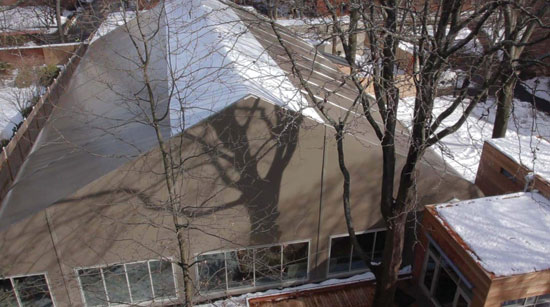
Photo courtesy of Kitchens To Go/Sprung Structures
The architectural membrane affords architects the ability to enhance creative solutions using a strong, environmentally friendly, and energy-efficient product.
Kynar formulated PVDF resins are one of the most stable and purest of all commercial resins, and are designed for permanent or long-term applications. The technology of protective coatings was first introduced in the late 1940s and continuously developed. It has evolved through the subsequent years with technological innovation. Initial applications occurred in chemical handling due to the resin's exceptional chemical resistance, and subsequently in other protective uses such as wire insulation, and ultimately in building protection due to its environmental durability.
Today Kynar PVDF is widely accepted for superior long-term performance where color retention, weatherability, and low-maintenance reliability are required. In architectural membranes, Kynar PVDF extends membrane life, protecting the aesthetic appearance, improving cleanability, and offering exceptional fire-retardant capability. Kynar PVDF-coated membranes offer low maintenance and a clean, bright look that is conducive to graphic treatments.
Weighing approximately 24 ounces per square yard, a Kynar PVDF-coated fabric has a blackout design that prevents solar gain and manages climate control while guarding against UV and airborne contaminants. Color choice is also among the many hallmarks of the architectural membrane.
In addition to Kynar PVDF-coated fabric, Dupont Tedlar film is an excellent, highly versatile polyvinyl fluoride film (PVF) that when bonded to PVC membrane provides long-lasting protection against extreme weather, fading, cracking, and corroding.
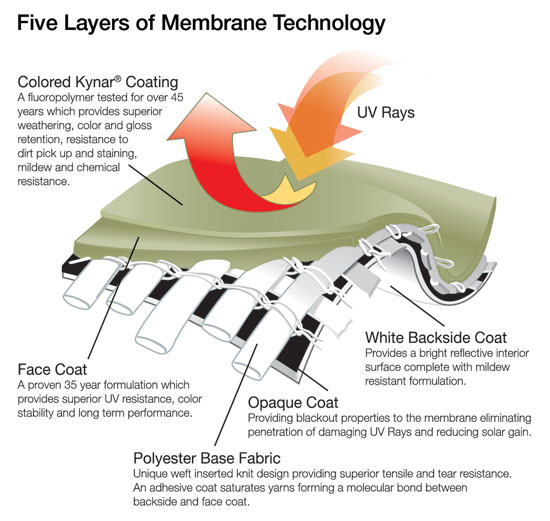
Photo courtesy of Sprung Structures
Five layers of membrane technology make for an ultra strong material. As the accompanying illustration shows, these levels include a polyester base fabric, an opaque coat, a white backside coat, a face coat, and a colored fluoropolymer (Kynar) coating that provides superior weathering capability.
For shorter-term applications, acrylics are a good choice as a top finish on architectural membrane structures, too. The acrylics help to block the liquid modifiers from reaching the surface and inhibit dirt collection. Acrylic resins contain esters and incorporate other functional groups which are susceptible to photochemical degradation and hydrolysis, both of which are found in environmental exposure. These high-strength rip stop membranes are light weight, at approximately 18 ounces per square yard, and are opaque for maximum longevity and energy efficiency. They have superior fire retardant capability and their blackout design prevents solar gain and manages climate control. Many acrylic membranes are available in white, grey, or tan.
Some membranes are designed for extreme cold weather installations, with specialized low-temperature cold crack characteristics making an architectural membrane flexible for installation in extreme conditions of up to -60°F.
Insulation. Insulation performs better in an architectural membrane structure due to a number of reasons, not the least of which is the lack of differentiation between wall and roof, which means that a more consistent R-value rating is achieved throughout the entire building envelope. Unlike a metal building that compresses insulation at many locations within the finished product and lowers the R-value, an architectural membrane structure keeps the insulation much closer to its maximum thickness for optimal performance and comfort, reducing climate control costs. Consequently, the structure is ideally suited to almost any climate.
Some manufacturers, for example, utilize a double vapor barrier system eliminating mold and mildew, and a reflective foil backing doubles both as a vapor barrier and to retain and reflect radiant heat, adding to overall energy efficiency. The blanket itself can be as much as eight or nine inches thick, exceeding building code requirements. Further, the R-25 or R-30 rating of the fiberglass blanket contributes to an extremely energy-efficient system. In terms of sustainability issues, fiberglass has been certified by third-party testing to have a minimum recycled content of 25 percent, comprised of 20 percent post-consumer bottle glass and 5 percent post-industrial glass.
In addition, a membrane structure has up to five times the airtightness of a conventional building, further contributing to their surprising energy efficiency.
Benefits
Architectural membrane structures offer a host of benefits over conventional construction.
Design flexibility. Available in widths from 30 to 200 feet and in any length, fabric structures are quite versatile. They can often be butted up directly to a conventional building, or easily attached through a sealed connecting corridor system in widths up to more than 19 feet. As opposed to metal or other types of buildings which experience some limitations due to lower interior clear height, fabric structures have excellent clearspan views, making high ceilings easily achievable. Acoustically sensitive applications are suitable, too, as the curved profile of the structure creates an interior free from conventional flat walls and corners. The soft interior fabric walls effectively absorb sound, resulting in superior acoustic properties.
With a tall, column-free structure, design professionals and owners have the advantage of working in a flexible, open volume of space in which to install a unique and customized system of walls and other interior features. Light and space are accentuated in a fabric structure, too, as natural daylight infuses the area with a warm glow, high roofs create depth and roominess, and glazing walls add to the open and inviting characteristics of the building envelope. For additional daylight, a translucent daylight panel section can be specified as an integral part of the architectural membrane. Conventional glass curtain walls or glazing walls can be designed and engineered to integrate with the arched profile of a fabric structure.
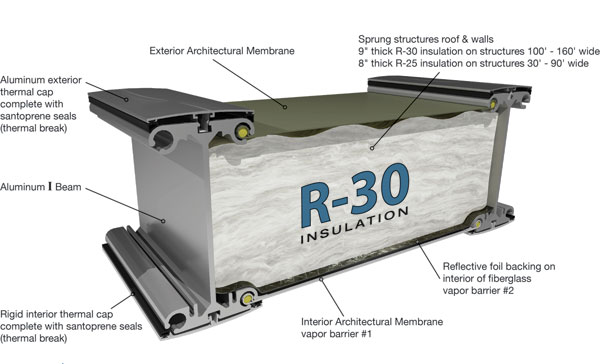
Photo courtesy of Sprung Structures
Fabric structures allow for easy expansion or reduction over its service life, and can be dismantled, reconfigured, and re-erected for a number of applications. There are many color options, all of which are proven colorfast and weatherproof, and colors can generally be mixed and matched cost effectively by choosing a complementing wainscot.
Faster construction speed and lower costs. Fabric structures are engineered to enable lower project costs and reduced operating expenses, and are often chosen for their speed of deployment. Completion of an entire architectural membrane structure takes a fraction of the time of conventional construction alternatives. Custom structures can be erected at a rate of up to 1,000 square feet per day for insulated structures, and 2,000 square feet per day for non-insulated structures.
There are several reasons for this. The permitting process, for example, can be substantially reduced as manufacturers typically will supply a comprehensive permitting package, complete with drawings and supporting calculations, all stamped by a licensed engineer certified in the region where the project is located. In addition, the lightweight aluminum substructure reduces the size of footings or foundations when compared to conventional steel buildings, and provided appropriate soil conditions exist, less permanent applications require no subsurface foundations for structures up to 180 feet wide.
Depending on the complexity of the fabric structure, design time can average three to four weeks versus two to three months for a pre-engineered building and six to eight months for conventional structures, with construction completed in six months, in some cases half the time of the other two types of buildings. All components come to the site pre-fabricated. Arches can be raised and the exterior membrane installed within a few days of commencing work, giving contractors a roof overhead very early in the erection cycle, and allowing construction in extreme weather and climate conditions.

Photo courtesy of Kitchens To Go/Sprung Structures
Glazing walls help maximize interior daylight.
Maintenance is minimal as the aluminum substructure is maintenance free, and the architectural membrane is easily cleanable. Conventional buildings require regular maintenance and with a pre-engineered metal building, a standing seam metal roof is prone to large thermal movements that create leaking and require continuous maintenance, especially at penetrations.
Durability. Fabric structures have a long life span and can withstand extreme weather. In particular, the aluminum substructure has an indefinite life expectancy, and the architectural membranes average a 20-year life span. Future replacement membranes are inexpensive.
Energy efficiency. Constant research, testing, and development have led to fabric structures that provide better climate control. As mentioned previously, thicker insulation used leads to maximum performance and comfort as well as reduced climate control costs and sound absorption. Insulation performs better because a highly tensioned exterior architectural membrane structure provides a significantly better airtight building envelope than conventional building envelopes. High performance architectural membrane structures are designed to keep warm air in, and cold air out and, combined with an effective climate-controlled insulation system, can achieve low air permeability—nearly 0—that can yield up to 45 percent savings on energy bills compared to pre-engineered metal buildings and other conventional structures. Poor airtightness is a drawback of pre-engineered metal buildings, though moderate air tightness can be achieved in conventional construction. A PVC-coated fabric on both the interior and exterior of the structure, in fact, can provide five times the airtightness of a conventional building, increasing the efficiency of the insulation and lowering HVAC and other operating costs.
Interim Kitchen Facilities
Interim kitchens are a new opportunity available to architects, foodservice consultants, general contractors, and the foodservice marketplace as an alternate solution to be able to provide continuity of foodservice operation during a time of planned or unplanned renovation of an existing foodservice facility or in the event of a natural or manmade disaster. All market segments of the foodservice industry utilize interim kitchen facilities, including education, healthcare, corrections, military, disaster relief and recovery, natural resource work camps – oil and mining, business and industry, hospitality and catering, quick-serve (fast food), and senior living.

Photo courtesy of Kitchens To Go
Bolt-on kitchens provide the ability to create extra space or transform a facility without the inconvenience of rehab and renovation.
Types of Interim Kitchens
Various types of interim kitchen facilities can meet foodservice operators needs and present benefits over alternative solutions.
Bolt-On kitchens. New food-service production facilities can be fabricated and either temporarily or permanently connected to an existing building. Reasons to consider a bolt-on kitchen include a facility expansion, addition or replacement; reallocation of existing interior space for alternate applications such as administrative and dining; expanded production capacity; additional prep space, cold and dry storage.
Providing the ability to create extra space or transform a facility without the inconvenience of rehab and renovation, this option is geared toward commercial food service operations that do not have the luxury of waiting up to eight months for permit approvals, design plans, and the traditional build out. Rather than disrupt daily food service operations, owners can take delivery of new code-compliant kitchen generally within a two- to three-month period in a process that trumps conventional construction in terms of a more efficient building profile that generates less waste. By affixing a pre-constructed kitchen to an existing building, operators can save both time and money over conventional construction costs. Because the fabrication takes place concurrently with the renovation's site development work, the projects run on parallel timelines—a scenario that reduces downtime substantially compared with traditional construction. The solution also provides the opportunity for operators to recapture existing space in their facilities for other applications, such as expanded dining or administrative space by moving the existing kitchen outside the building's footprint.
Architecturally, the modular unit's design can match the décor of the existing building to which it is adjoined. The bolt-on kitchen is joined by a common sidewall and delivered with an interior and exterior that are custom finished to reflect the operator's brand image. The facility is sufficiently versatile to serve as a permanent structure that is built to current building codes; alternatively it can be relocated wherever it is needed. LEED-certified bolt-ons are available.
Mobile kitchens. Candidates for mobile kitchens include quick-serve and off-premise foodservice operators for a spectrum of education, healthcare, corrections facilities as well as for first responders that assist victims of natural and man-made disasters.

Photo courtesy of Kitchens To Go
Candidates for mobile kitchens include quick-serve and off-premise foodservice operators.
Modular kitchens. As distinguished from traditional mobile kitchens, modular kitchens involve both single unit modules (SUM) and modular kitchen complexes. Modular kitchens are often used when food service operation requires a new permanent facility, or drive-thru concept. These kitchens are a purpose-built, clear span space that enables an efficient commercial kitchen environment. Both health and building code compliant, these facilities include certified exhaust hoods with engineered make-up air, fire protection systems, and HVAC.

Photo courtesy of Kitchens To Go
As distinguished from traditional mobile kitchens, modular kitchens involve both single unit modules (SUM) and modular kitchen complexes.
PAC kitchens. Plug-and-cook (PAC) kitchens are single containerized units that provide substantial production cooking capacity in an easily deployable unit that can be placed and operational in 45 minutes. PAC kitchens are ideal for military applications, disaster relief or special events. With optional hydraulic leveling legs, this type of kitchen can be easily moved by trailer and lowered to ground level. With the entire sidewall opening up, a enclosure can be incorporated to allow for additional prep or dining space. In addition, multiple ISO containers can be placed adjacent to each other to create a commercial kitchen complex that can be shipped and lifted into place anywhere in the world. These units are designed to operate in extreme environments while maintaining a comfortable, efficient and high capacity work environment inside. Fire suppression systems are included, and options include propane, natural gas or electric models. The units range in size from 20 to 40 feet in length.
Benefits
Currently the alternative options to interim kitchen facilities are phased construction, outside catering, or a complete shutdown of the facility. Phased construction can take two to three times longer to complete than an interim kitchen, and accrue increased project costs due to extended “general conditions,” expended resources, and the like. Further, conventional methods can result in serious disruption of a facility's day-to-day operations, causing “construction fatigue” as occupants tire of the associated, noise, dust, and inconvenience.
Outsourced catering can be extremely costly, running 20 percent to 30 percent more than in-house production. With outsourced catering the host facility has limited control over food safety, quality, and consistency and may have to reduce original staff which can affect morale. Complete shutdown of a kitchen is not always an option. It can add productivity stress on other operations, and decreases the level of service provided to consumers.
In terms of administrative arrangements, interim kitchen facilities rent by the month, with additional charges for transportation to and from the site location, set up, commissioning, de-commissioning, cleaning, and removal at the end of the rental or lease period. Interim rental or lease periods range from one to more than 36 months with the average lease period being six to fourteen months. The process for utilizing an interim foodservice facility is very similar to the design and build process for a permanent building. Code approvals are also similar except that the prefabricated kitchen units are reviewed and inspected by third agencies approved by the state in which the units will be installed.

Photo courtesy of Kitchens To Go
Plug-and-cook kitchens can be operational in 45 minutes. Integrated hydraulic powered legs facilitate the unloading of the unit.
Interim Kitchen Facilities Make for Good Business
Renovations of existing facilities can be a double-edged sword. A new modernized facility is in the making, which is a good and necessary thing, but what happens to users of the existing facility while renovation proceeds? When it comes to food service, phasing, catering, or outright closing the existing facility may not be valid options due to cost, convenience, or logistics. Interim kitchen complexes, which can be erected quickly and can take over the full food service capabilities of the existing facility, represent a high quality, cost effective solution. Building code and health code compliant, the interim facility is a resource that architects and owners can turn to as an effective element in a renovation master plan.
Endnotes
1) Kynar is a registered trade name from Arkema.
2) Products that carry the Kynar name are licensed formulas with very high levels of the Kynar PVDF resin and should not be confused with PVDF top finishes that are mostly acrylic resins.
  |
Sprung Structures engineered high-performance, tensioned membrane structures are designed to provide innovative, cost-effective building solutions for interim and permanent applications. Kitchens To Go is an industry leader in mobile and modular commercial kitchen solutions. Combined they can supply an immediate custom solution for state-of-the-art dining facilities worldwide. The “Kitchens To Go Harvard Business School” video can be viewed at www.sprung.com/video/harvard-business-school-dining-facilities or www.k-t-g.com/video/harvard-business-school-temporary-kitchen-complex. www.sprung.com and www.k-t-g.com |

